Interview with Michael No : Ogasawara-ryū Archer
Author: Jessica Gerrity(Instagram/Twitter @jessintokyo)
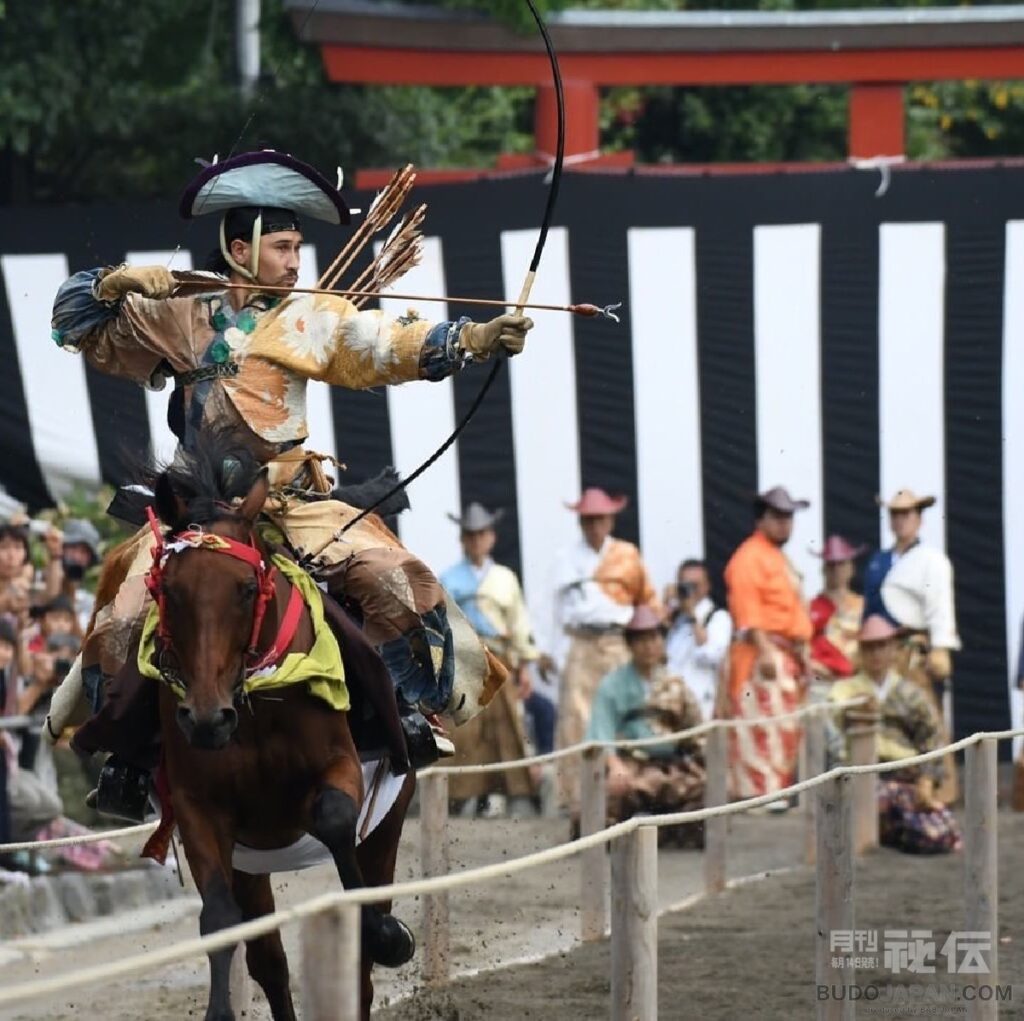
Location: Tsurugaoka Hachimangu Shrine Photographer: Takarada san IG @takarada.dakara
Hello everyone this is Budo Japan Ambassador Jessica.
I had the special opportunity to interview Michael No san who practices the traditional form of kyubajutsu or mounted archery with Japan’s oldest surviving school of etiquette, kyujutsu and kyubajutsu Ogasawara-ryū.
In a previous article I detailed two types of horseback/mounted archery that are practiced currently in Japan: kyubajutsu/yabusame shinji and sports yabusame. As a sports yabusame practitioner myself I had so many questions for Michael san.
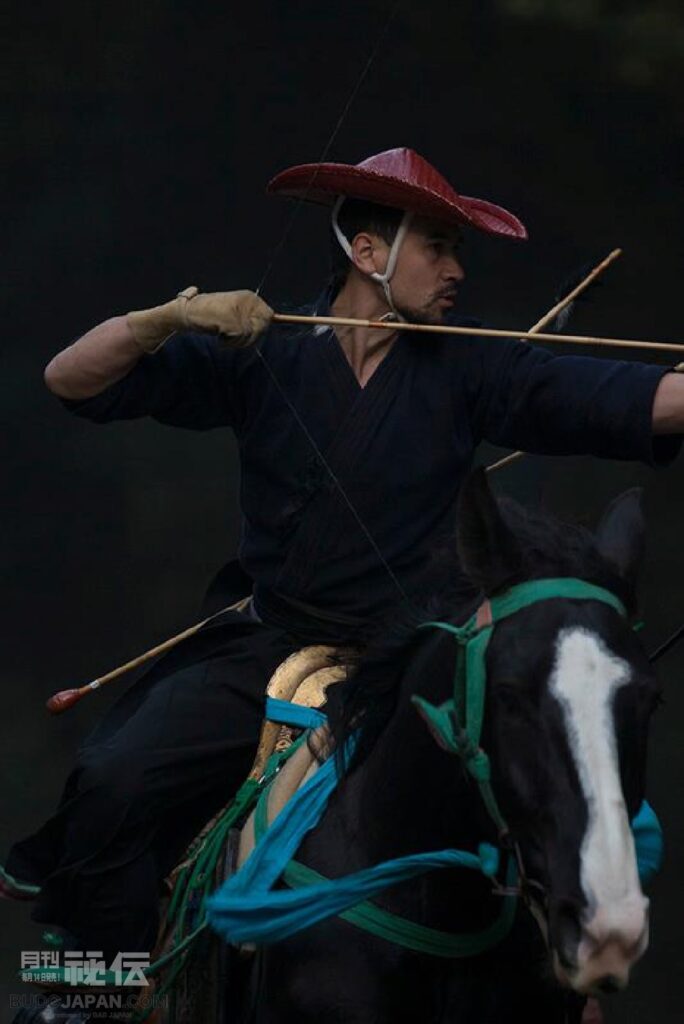
Location: Kasuga Taisha Photographer: Moriyama Masatomo 森山 雅智
Before we get into your background may I ask about Ogasawara-ryū, the school you belong to?
Yes, Ogasawara-ryū is one of the two remaining historical schools that continue the transmission of yabusame. The history of the school dates back to the Kamakura period and is quite fascinating, as are the teachings. It’s also amazing that it has persevered for some 830 odd years, all while staying in the Ogasawara family for 32 generations now.
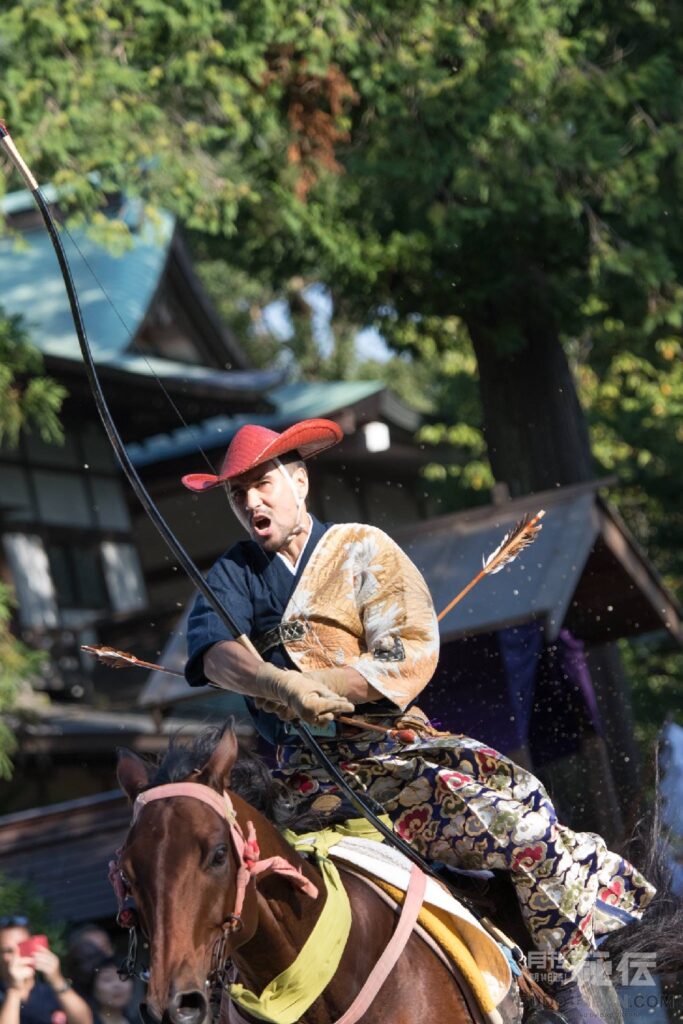
Location Tsurugaoka Hachimangu Shrine Photographer: Morizaki Kiyomitsu 森崎 清光 IG @kkmorizaki19
The Ogasawara-ryū website states:
“Ogasawara-ryū is a school of etiquette, archery, and mounted archery that views etiquette as the building block of its techniques. Performing movements correctly one at a time, the movements become a part of the practitioner as they begin to correspond to the needs of space, time, and man.”
“The movements of etiquette then flow to become the basic footwork required in archery. These in turn become the cursive movements of mounted archery that the practitioner learns within the Ogasawara-ryu tradition.”
Introducing Michael No
Hello there Michael san, please tell me a little about your background. Where are you from and what originally brought you to Japan?
I’m from the settlement of Melbourne on the island nation of Australia. I’m in my 11th year here in Japan, and arrived by airliner. Silliness aside, I always thought Japan would be interesting but it was really only through getting to know a few Japanese friends back in Melbourne that I was prompted to visit in the winter of 2008. I enjoyed it so much, I came again in summer of the same year for 6 weeks. A few years later, I decided to undertake a working holiday here. Initially the plan was 6 months, however the amazing people, culture, landscapes, and experiences I had led me to extend my stay a little.
It sounds like you really love your life here in Japan. How did you get started with yabusame? Did you have past experience with horses?
When I arrived in Japan I had 3 goals: train judo, kyudo, and if at all possible yabusame. My interest in mounted archery originated in my interest in both horses and archery as a kid, my grandparents were accomplished horsemen, along with many relatives, from a young age I had an admiration for horses, as a teen I spent a lot of time in the bush hunting with both rifle and bow, the mountains were populated with the iconic wild brumby horses.
It was in those years that I had a dream of shooting arrows from a galloping brumbies bareback. Then in my mid 20s I saw yabusame on the world wide web, I knew that’s what I needed to do.
When I moved to Japan, I learned about traditional and sports yabusame, though sports yabusame felt more realistically accessible to me, I was quite set on the Ogasawara school, after year in Japan my yabusame fever was getting intense, so I was thrilled when on a trip to Nikko I had a chance to meet members of the school, after expressing my desire to learn, I moved to Nikko a week or so later and began training. It took about a year to gain membership and another year to debut, which I did so in 2015 at Tsurugaoka Hachimangu in Kamakura.
I’ve now been practicing yabusame coming 10 years, my current rank (menkyo) is called nurimuchi (means lacquered whip).
That’s amazing, it sounds like destiny to me!
The ceremonial side of kyubajutsu or yabusame shinji looks like it has many steps, a prayer, blessing of archer and their bows etc, could you please explain a little more?
Yabusame is a shinto ritual, where a select number, usually 3 main ritual archers called ite, and maybe 15 or so other archers called kisha hasami mono. These mounted archers will in turn, attempt to hit 3 targets spaced evenly along a straight track while at a canter or gallop. The track is usually around 200m long and somewhere within the shrine grounds. Usually the ritual is held on the same day annually or in some cases biannually.
As I understand there is a specific process that takes time before the mounted archery begins, could you explain a little about this?

Photographer Morizaki Kiyomitsu 森崎 清光 IG @kkmorizaki19
Prior to yabusame starting there is ritual purification of riders, horses, and worship of the kami (god) of the shrine which is held by the priests. Prayers for peace and good harvest are common. The act of yabusame itself is a sign of dedication to please the kami with a good performance, the more targets that are hit the greater the harvest or peace etc will be.
Though it’s not a competition between riders, some shrines award riders who hit all three targets with a length of white silk cloth.
I imagine behind the scenes, the months and days leading up to the yabusame shinji itself, there are a lot of preparations involved that the public does not see, is this true?

Location: Moscow, Russia Photographer: Moriyama Masatomo
Yes, all of the above is the “main event” that the public can witness, and is usually completed within 90 minutes or so, and an individual run will be over in 15 seconds or so, however like most things 90% is preparation, it’s an all hands on deck occasion. We all usually arrive the day before to acclimatize the horses, introduce them to the track, exercise the horses, then we will go into the evening carefully checking, and reassembling the Edo period saddles, which includes hand making hemp strings from raw hemp fiber.
We will do a dress rehearsal with the local volunteers, and teach the various roles and positions to the volunteers for the parade and ritual, everyone heads to bed after all the preparations are done. Usually on the day of the ritual we are up at 4am to feed the horses, muck out the stalls, saddle them, and take them out for early practice, after which we retighten the saddles, and start all the other preparations for the main ritual, we are usually packed up and ready to head back home with the horses around 6pm or so, they are a couple of long action packed days.

Photographer: Morizaki Kiyomitsu 森崎 清光
The events sound quite physically demanding and as such I imagine your training to be quite intense also. How often do you train and what kind of training do you do?
For Ogasawara-ryū the majority of our training consists of kisha taiso (horse / sumo stance training), mokuba keiko (wooden horse training), along with reihou (etiquette), we also do ridden practice several times a year and also prior to rituals throughout the year.
The kisha taiso is used as a warm up and leg strengthening exercise, the posture used is similar to the riding position. Mokuba keiko practices the correct riding position, and shooting form in the saddle. I usually practice once or twice a week but often more during yabusame seasons of spring and autumn.
Etiquette is physically quite taxing, most people would be surprised how hard it is to simply sit, stand and walk in accordance with shogun class samurai etiquette.
Independently I’m physically very active, I currently work with 9 horses weekly, often riding a couple of horses a day most days a week. Also I do a variety of outdoor sports, and enjoy various strength and cardio training to support my lifestyle. As for diet, I’m not fanatical (yet), but increasingly I take more and more care of what I eat, though this winter I’ve been a bit slack with the vegetables.
Having daily contact with horses is wonderful. It sounds like your work and passion for yabusame is very well matched. Do all yabusame practitioners with Ogasawara-ryū work a 9 to 5 job?
Yes, everyone including Ogasawara sensei makes their living from regular jobs. I work in the tourism industry as a manager for project planning and sales, my main focus is inbound markets, working with various agencies and media to promote the culture park I work for as well as the city of Nikko.
In addition to this I have a role managing our company’s small stable, and also for the last year or so have been working as trainer, hoof trimmer, and advisor for Nikko Toshogu shrines equine facility. There I get to help take care of the shrine’s sacred horse (goshinme) and the other horses used for yabusame and various festivals.
You have such a broad range of skills and a wonderful career. Other than yabusame do you train in any other martial arts?
Currently no, but I grew up in a martial arts family, my father established a judo and taekwondo club when he immigrated to Australia in 1960. I grew up doing both since I could walk, however by my early twenties I stopped training both. Later on I went back to judo which I continued when I came to Japan. It was at that point I also started kyudo while living in Saitama, however once I moved to Nikko I’ve really only focused on yabusame.

Morizaki Kiyomitsu 森崎 清光 IG @kkmorizaki19
My stereotypical image of a yabusame archer is a Japanese person. What is it like as an Australian yabusame practitioner riding in Japan?
My sentiments have changed over the years, it has been a journey. I have often heard people express the strangeness of a foreigner doing yabusame, and though it is uncommon for sure, it’s also uncommon for Japanese to undertake such things, there really aren’t a lot of members. I’d like to think that all our motivations are quite similar.
At the rituals, while on horseback walking past the thousands of spectators you can always hear some interesting comments of astonishment emanating from the crowd, something that used to be distracting but that I am very accustomed to now. I greatly appreciate that within the school I feel I’m treated with the same standard and sensibility as other members.
Please share a good memory or memorable experiences you have had as a member of the Ogasawara-ryū.
I have many many great and happy memories. There are two events of notable positivity. I was very surprised to be chosen as the opening rider for Shimogamo shrine in Kyoto, I had heard it was a particularly conservative shrine and never thought I would ride as one of the opening riders, but I was put forward, and it was the first time a non-Japanese had ridden there as Ite in history, and it was also the first yabusame for the new Reiwa era!
Another and even more unexpected privilege, was being among the Ogasawara-ryū members chosen to go to Moscow together with priests from Tsurugaoka Hachimangu to perform a yabusame ritual, organized by the Japanese embassy to celebrate diplomatic relations between Russia and Japan.
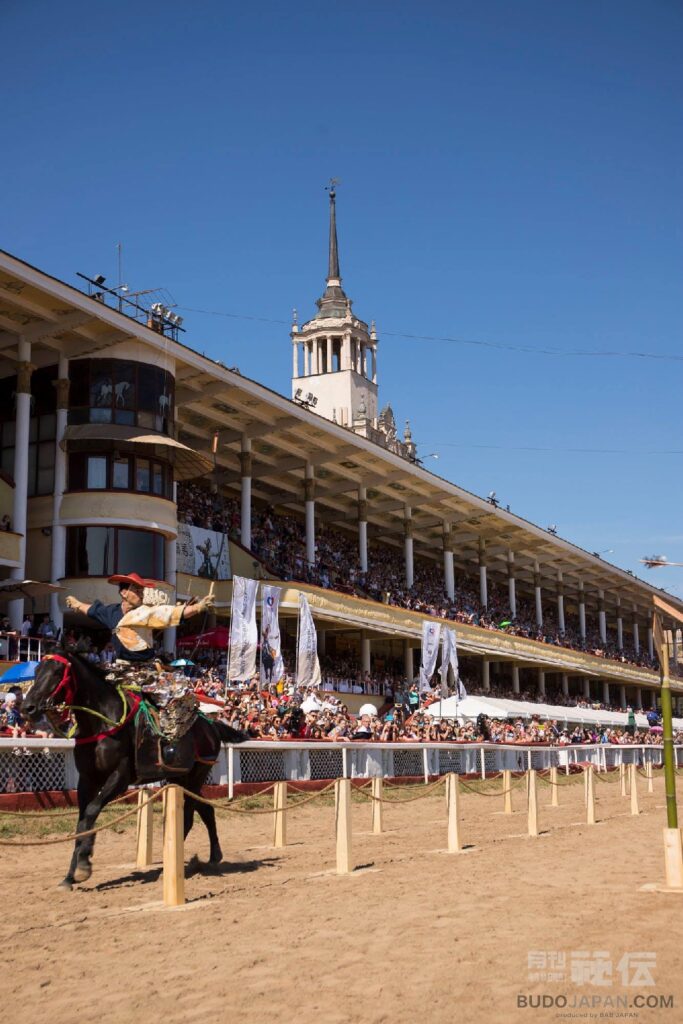
Photographer: Moriyama Masatomo 森山 雅智
It sounds like you work and train seriously and are a wonderful archer. Please let us know your plans or dreams for the future.
At some point I’d love to have my own magical property with a beautiful old farm house and backdrop, some small fields for farming, and a training facility focusing on very refined, intelligent, and gentle horsemanship. In hand with that I’m always very focused on further developing my horsemanship, to become the kind of rider and trainer that horses deserve.
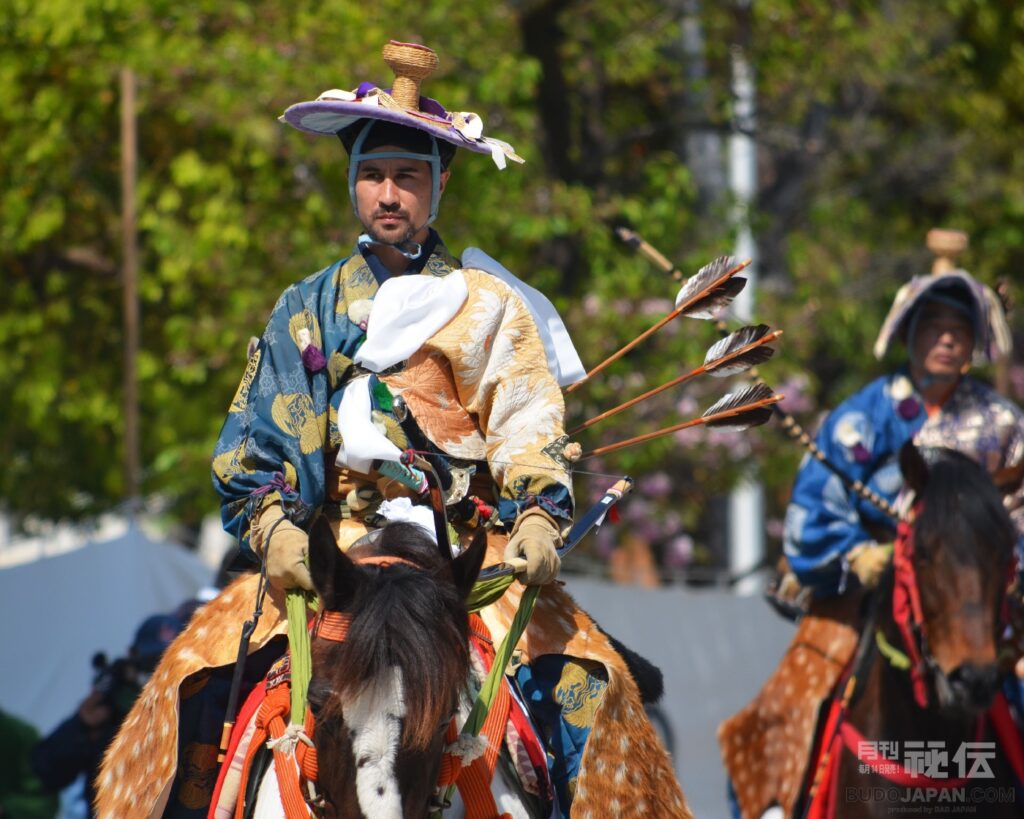
Location: Asakusa Photographer: Joffrey Maubert IG @suna_no_shiro_
Lastly, where can people see Ogasawara-ryū yabusame shinji events? Which one would you recommend to visitors to Japan?
I think any yabusame event would be interesting and unforgettable thing to witness, however based on overall atmosphere, history and beautiful surroundings, my all time favorite Ogasawara-ryū yabusame rituals would have to be Nikko Toshogu, Shimogamo shrine, and Tsurugaoka Hachimangu.
Upcoming yabusame shinji
Shimogamo shrine yabusame, Kyoto, May 3, 1pm – 3pm
Nikko Toshogu yabusame, May 17, 1pm – 2:30pm
Asakusa yabusame, Sumida Park, May 27, 1pm – 2:30pm
The calendar of all Ogasawara-ryū events can be found at
http://www.ogasawara-ryu.gr.jp/english/index.html
Thank you for your time Michael san. Good luck for future endeavors and I hope I can come to see you ride someday.
Thank you Jessica san, look forward to meeting you in the future!
The photos contained in this article are subject to copyright and are not to be shared without the express permission of the photographer listed below each photograph.
SNS
Ogasawara-ryū’s official Instagram
@ogasawararyu
Michael’s Instagram
@maikeruno
List of all photographers
- Takarada san
IG @takarada.dakara
- Moriyama Masatomo
森山 雅智
- Joffrey Maubert IG
@suna_no_shiro_
- Morizaki Kiyomitsu
森崎 清光
IG @kkmorizaki19
IG @note_in_kamakura
PHOTO BLOG 鎌倉への付箋note in kamakura
https://blog.goo.ne.jp/note_in_kamakura
HP:K+K DESIGN ROOM
https://kkmorizaki.jp/














